“Indian Women Open Up About The Pressure To Keep Their Hair Long And Straight - HuffPost” plus 4 more |
- Indian Women Open Up About The Pressure To Keep Their Hair Long And Straight - HuffPost
- At home hair coloring tips and styling tricks for quarantine - Los Angeles Times
- Shades of 50: how the midlife woman went from invisible to the main event - The Guardian
- 'Beauty is freedom': The North Korean millennials wearing makeup to rebel against the state - CNN
- The Coolest 80s Hairstyles for Men to Rock This Year - The Trend Spotter
| Indian Women Open Up About The Pressure To Keep Their Hair Long And Straight - HuffPost Posted: 03 Mar 2020 02:55 AM PST In India, hair and femininity are inextricable. The trendsetting industries of film and television, firmly in the grip of conservatism, haven't shown much interest in broadening our understanding of femininity ― on or off screen, no A-list actors sport hair that isn't well past their shoulders, and an artfully waved lob is considered radical. Popular fashion designers like Sabyasachi, who premised their careers on challenging conventions of femininity, are now associated with deeply traditional iconography that features women in long, demure hairstyles. Quick to co-opt this idiom, the makeup and fashion influencer communities mimic these looks with relish. The country's biggest national pageant has been panned for selecting candidates with bizarrely identikit hair. In ads and in movies, short-haired women are either mouthy tomboys, athletes or staunch careerists. They are almost never mothers or love interests. Short hair is for feminists and intellectuals ― a shrill, frumpy archetype devoid of softness and disinclined to pander. The renunciation of hair is acceptable only when sanctioned by religion or custom, not when it is a political statement or an act of self-love. Class and caste readings of hair throw up depressingly predictable themes. For example, when Priyanka Gandhi, scion to the first family of India's oldest political party, cut her hair, she became the subject of fawning press that likened her look to her grandmother's, the first female prime minister of India. Hair diversity is a problem, too. Big banner movies and commercials almost never feature curly haired leads. Curls do not feature in hair product ads and do not get the kind of care they need at most salons, because stylists consider kinky hair difficult. Curly brides seldom wear their natural hair and go pin-straight on their big day; mainstream bridal fashions simply don't factor in curls. All of this underscores a cultural obsession with straight, "proper" hair. Shockingly, the country has only just begun to wake up to hair diversity. We talked to eight Indian women about their fraught experiences with their hair.
Priyanshi Jariwala, Surat, Gujarat (Western India)
Jariwala owns a sustainable fashion line that champions a hardy hand-spun fabric with ties to India's freedom movement. Growing up, she struggled with her curls. "I wanted to straighten them all the time only to be accepted. I remember a morning from my fourth grade when my teacher asked me if I'd combed my hair enough. She suggested I do it multiple times to get rid of the 'shabby look.'" Jariwala has strong feelings about her community's grooming expectations of women, considered attractive only if they are "tall, fair, slim and have long hair, even if the man has none on his head." She's glad for a dear friend who was so fed up she "cut her hair short to avoid marriage proposals. Women with short hair don't qualify for Daughter-In-Law of the Year," she said. Jariwala believes that women in visual professions, such as modeling, can sometimes pay for asserting their individuality. "I know fashion models who lost work because they decided to chop their hair. I think this bias is deeply rooted in the idea that long hair hides the 'less attractive' features, like chubby cheeks and an undefined jawline." When it comes to her own profession, she plays it safe. "I work in a creative field where people are more accepting of your choices and appreciate nonconventional haircuts/colors, but I find myself at a crossroads when it comes to a conference or business summit. I do not remember ever leaving my curls open in a meeting. They are either tied in a bun or styled." Then, colored hair signals sexual adventurism and could get women into trouble. "Women with crazy hair colors are [believed] to be asking for it, just how they're asking for it when they wear short skirts or tops with deep necklines," she told HuffPost. Despite comparisons to Maggi noodles, she's found peace with her hair. "I think my hair is a representation of my wild and carefree side. People tell me that my hair makes me come across as a warm, approachable individual."
Rachana Iyer, Mumbai, Maharashtra (Western India)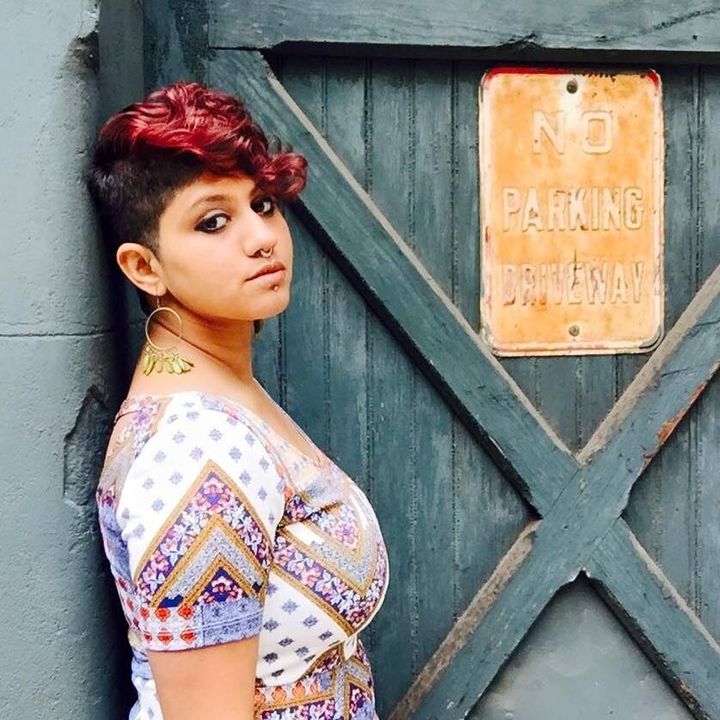
Tamil by origin, Iyer is a mental health advocate and heads corporate social responsibility for a private bank. Fair skin and long hair are prized in her community and Iyer wrestled with her wavy curls, first growing them to waist length, then chopping them off to make a political statement. "I felt compelled to challenge the notion that I could look my best only in long hair," Iyer told HuffPost. "I went from blunt to pixie and finally a beautiful red faux hawk! I absolutely loved the feeling of buzzing my hair and almost got quite addicted to it. Most people were shocked and upset that I would even take such a drastic step. This made me want to keep cutting my hair. I wanted people to realize how narrow their view of beauty is. People link femininity to having long hair and assume things about you based on its length. Although I do identify as bisexual, most people saw my short hair and called me names like 'butch' or 'tomboy.' They assumed that my sexuality and hair were somehow linked." Iyer doesn't care. She has attended weddings in traditional saris sporting buzzed hair, a vision undoubtedly jarring to her conservative community. "People assume you are a 'junkie' or a 'punk' when they see you with a buzz cut. I think coloring longer hair does not evoke the sort of response that coloring shorter hair does. I remember walking into a very popular bank and the lady at the counter openly mocked me to her colleagues and treated me poorly because of my hair. It got so bad that I had to escalate this to the manager. Society, especially women, can be really quick to judge you based on your hair. People also tend to slander a woman's character, and although very subtle, I have personally experienced people thinking I am 'very open,' 'forward thinking.' They have taken the liberty to flirt even when I was clearly not interested." Iyer believes that workplaces aren't hair-inclusive. "A lot of companies have a policy about the types of colors allowed on women's hair. Advertising agencies and the entertainment industry are a bit more relaxed, but there are still clear assumptions made based on the length of your hair. Medium or long hair that is straight, not frizzy and not colored, is considered the most professional. Most Indian corporations definitely consider buzz cuts unprofessional. It is assumed that you will not take your work seriously if your hair is fun!"
Theyie Keditsu, Kohima, Nagaland (Northeastern India)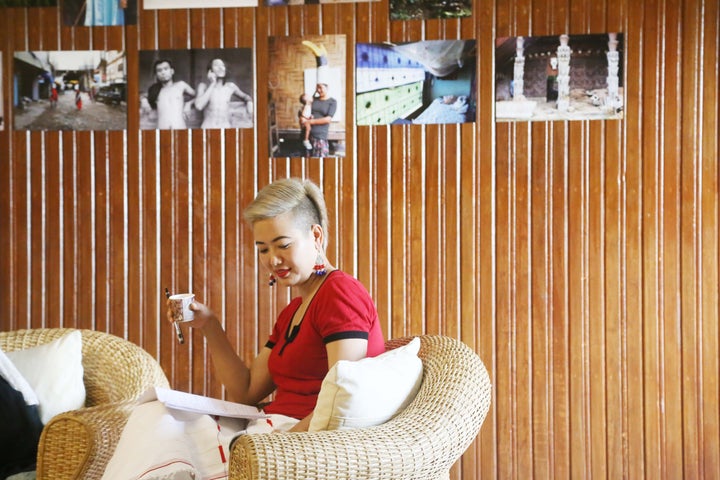 Keditsu teaches at a government college and advocates for the revival of traditional indigenous textiles and local artisanship. "Nagas (from the northeastern part of India) in general hold long, black and thick hair as the gold standard of feminine beauty. This beauty standard is both a result of racial prevalence and patriarchal notions of femininity," she told HuffPost. Keditsu's hair journey straddles the personal and the political. "I started shaving parts of my hair as a teenager," she said. "And then completely when I was 27. And then in parts from 2017 onwards. My parents disliked my latest experiments so much that they even prayed for me! For them, my mohawk was unbecoming of a mother and a responsible working woman. For some others, it clashed with their idea of Naga beauty and femininity. My husband loved it, as did most of my friends. The most recent experiments with my hair were simply a personal quest to explore what being beautiful meant to me. I'd reached a point of self-acceptance ― realizing that hair and other accoutrements of beauty were at once superfluous and vital to one's personhood. With my mohawk, I wanted to challenge ideas of what a mother should look like, and what made a woman my age beautiful. In a very deliberate way, I chose to sport these hairstyles because they expand the idea of what it means to be feminine." Keditsu would like young women to "see hair as a means not an end, not as an extension of oneself or one's sense of worth but as a tool to express one's politics or worth."
Niharika Chugh Vali, Nagpur, Maharashtra (Central India)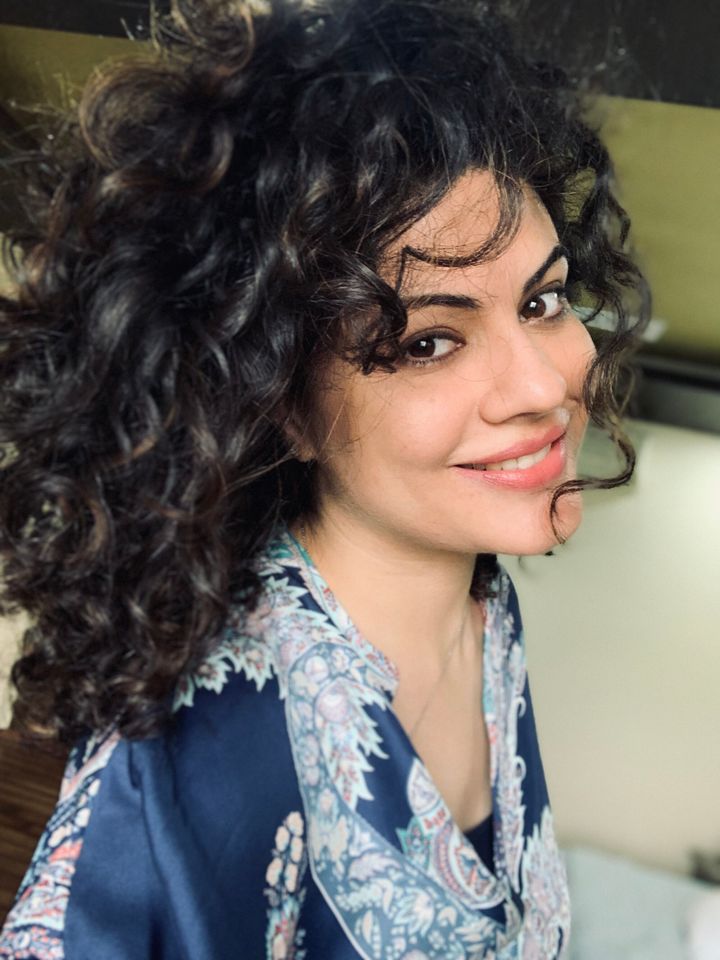
Business owner Chugh Vali runs a children's play area that encourages experiential learning. Her parents are Punjabi and Parsi, two cultures that value conformity in appearance, so she has only just now leaned into her big, curly hair. "I have worked before as a television news anchor and my hair was always a concern for everyone. It was gelled and tied back most times and when it was left open, it took twice as much time as anyone else to straighten it. The option of enhancing my natural hair or going curly did not exist," she told HuffPost. "Like all curly-haired people, I've been advised by stylists and well-wishers to 'do something about it,' to get my hair smoothed or straightened or treated with keratin, as if the sight of my natural hair could hurt someone's eyes," she said. Shame around hair was learned in early childhood. "The volume was unmanageable, so it was cut in a short bob. Once I did decide to grow it out, I made sure it was tied back real tight and pinned well so nobody ever had to see what it really looked like," she said. Today, Chugh Vali credits the Curly Girl Method and Indian actors like Kangana Ranaut and Taapsee Pannu for throwing out notions around "curly hair being an inferior hair type. It is also finally leading to a conversation about curly hair, and how its care is so different from the default straight-hair regimen we all follow blindly." Mother to a 7-year-year old, she loves that animated children's heroines like Merida ("Brave") and Moana have curly hair.
Daminee Benny Basu, Los Angeles/Kolkata, West Bengal (Eastern India) Basu is an actor and acting coach and comes from a family of theater veterans. Steeped in the politics of performance and the performance of politics, she's clear-eyed about concepts like beauty. "I grew up in the Bengali community. Bengali culture has so many references to feminine beauty ideals in literature, song and poetry. Like 'Lokkhi-meye,' good girl," referring to Lokkhi, the goddess Lakshmi. "It's the typical understanding of girls being pretty ― cascading hair, dark hair like clouds, skin tone like Lakshmi, well behaved," Basu explained to HuffPost. "These have been the ultimate paradigms for Bengali girls ― big eyes, beautiful nose, golden complexion." She points out that hair has always been weaponized to various ends since the beginning of time. And that even though shearing your mane off feels radical and original, it really isn't. "I've seen my friends rebel, do so much with their hair ― turn it into a canvas, turn it into a war zone of self expression the moment they go through a revelation or heartbreak. Aren't these learned behaviors, things we have seen, heard, been around? ... Using hair to protest is rooted in ideas of sexualization and desexualization. It's a power struggle. And it will happen for as long as both genders fight over equality." Basu has been witness to the friction hair can cause in families. "I've seen friends who wanted to get a particular cut or color their hair. But they couldn't, because they were afraid of what their mother-in-law would think. They'd have to discuss it with their husbands, take their permission. I remember asking a friend if her husband would ever think twice before getting a haircut, coloring his hair or joining the gym. Recently one of my closest friends got a really short haircut. She was excited about it, but her brother got pretty upset even though he has absolutely nothing to do with her lifestyle." Perhaps this is what drew her to Janis Joplin, even as a child. "She was my hair icon. I loved her hair because it was big and free. I've never seen a Janis image where she's done something fancy with her hair. It looks free and happy."
Naina Redhu, Gurgaon, Haryana (Northern India)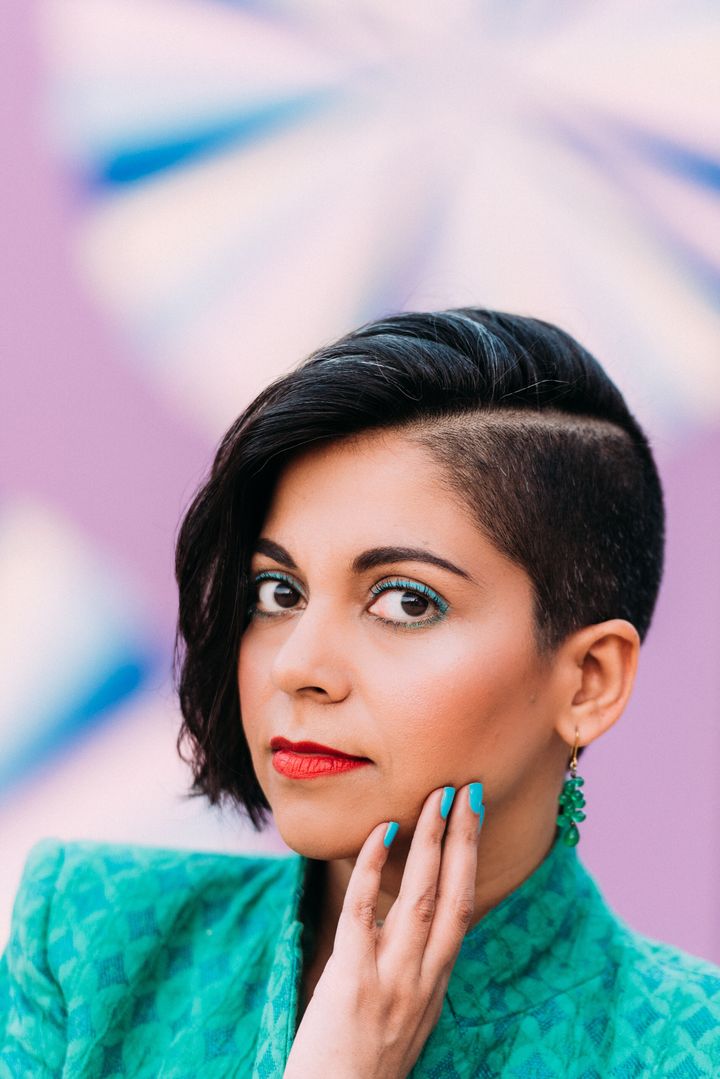 "I don't do salons," said Redhu, a photographer and visual artist who likes cutting her hair herself. "The last time I went I asked for a men's hairstylist and told them to shave my head with a trimmer. I said they'd better charge men's prices! I don't think I've seen a lot of 35-year-old women with buzz cuts in India. With mine, I was trying to say that age is just a number." Her first buzz cut was inspired by a male model she saw on Pinterest. "People think you're aggressive if you have short hair ― butch, unfeminine. Which works for me, because they leave me alone," she told HuffPost. She acknowledges that things would be harder if she lived in a smaller town. Surprisingly, she's faced little resistance to her choices in her parents' villages. (Known simultaneously for its gritty, incredible sportswomen and its chauvinistic khaps, an extrajudicial, community-based system of moral policing that punishes women cruelly for their transgressions, Redhu's home state of Haryana is a living dichotomy.) "Mostly, people have just been curious," she said. "I don't think they've judged me. I think when I was in college it was a little more on the nose because they'd harass you and say things like, 'Oh, are you trying to be a boy?'" She's gone bald in the past and received unwelcome attention for it. "I've had young girls ask me if someone had died. (Tonsuring is a common mourning practice among Hindu men and boys). People have messaged on Instagram or asked me, 'What if it doesn't grow back?!' And it always came from women. I blame things like Bollywood and television and not being guided better as children," she said.
Natasha Noel, Mumbai, Maharashtra (Western India)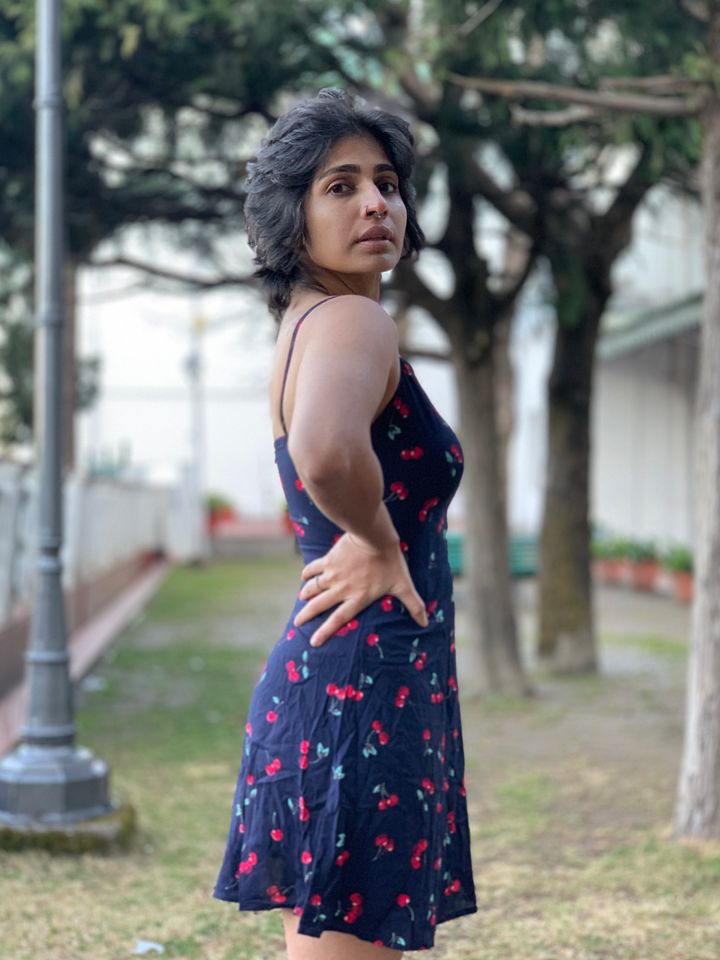
Noel is a yoga teacher and body positivity activist. In her Malayali culture (Noel's family has origins in the southern state of Kerala), long hair is considered beautiful. So when she first shortened her hair to shoulder length in high school, her father didn't speak to her for a week. She attributes his anger to patriarchal conditioning. "I went bald eight months ago and that was pretty wild. Didn't care about the consequences because on this journey of self-love and acceptance, I realized that I was using my hair as protection. I would untie it to take a picture because I believed I looked more 'beautiful' like that. And I didn't want a crutch, so I just did it," she told HuffPost. "Some friends said they didn't want to look at me. I said great, thank you, next." She hates that shorter cuts signal that it's open season on a woman's sexuality. That "she looks like a boy. That her femininity is in her hair and that that's what makes her a woman. This is bullshit. A woman is whoever she wants to be." Today, Noel feels liberated after consciously refusing to feed her hair anxieties. "Once I relaxed my obsession with my hair, I realized that beauty is on the inside. When I think of what I can do with my body and how I have inspired so many people and changed their lives, l realize my worth."
Ghazal Qadri, Baltimore/Jammu & Kashmir (Northern India) Qadri, an illustrator from Kashmir, was considered a tomboy for rejecting girly pursuits. "When the girls were busy wearing makeup, I played with trash or drew on my notepad. It was my mom who cared about my hair." When she was little, her mother had her hair cut in a short bob for convenience. Baby Ghazal would tie a black cloth to the back of her head and pretend it was a ponytail. Today, to her mother's frustration, Qadri has decided she wants it short all the time. As it is, her faith endorses modesty in attire ― women are expected to cover their hair and not keep it short. She's received unpleasantness from relatives on occasion. "When I leave my hair half-open they consider it indecent," she said. "But it doesn't matter much to me what others think of me or my hairstyle. I trust my parents' wisdom and guidance on what's proper." Qadri believes that beautiful hair isn't overcoiffed, but "casual, free and natural." She would like television to be honest about women's hair, not just put "silky straight hair" on the screen. "Nobody's hair shines so much in real life. When I was little I always wondered why mine wasn't like these women's." |
| At home hair coloring tips and styling tricks for quarantine - Los Angeles Times Posted: 31 Mar 2020 06:17 AM PDT If you aren't careful with your hair during the COVID-19 pandemic, your coming days might include having a man bob or a self-inflicted horror haircut or glaring color and extension outgrowth that reveal one too many secrets to your significant other or your colleagues on Zoom video chat. In search of answers, The Times turned to pro hair colorists and stylists in L.A. to get tips and tricks on how to best tend to hair during quarantine. One universal piece of advice: Tap into your usual stylist for personalized help and book a post-quarantine appointment now to beat the rush — as recent cancellations at some salons have caused future bookings to back up. At-home color kits Advertisement 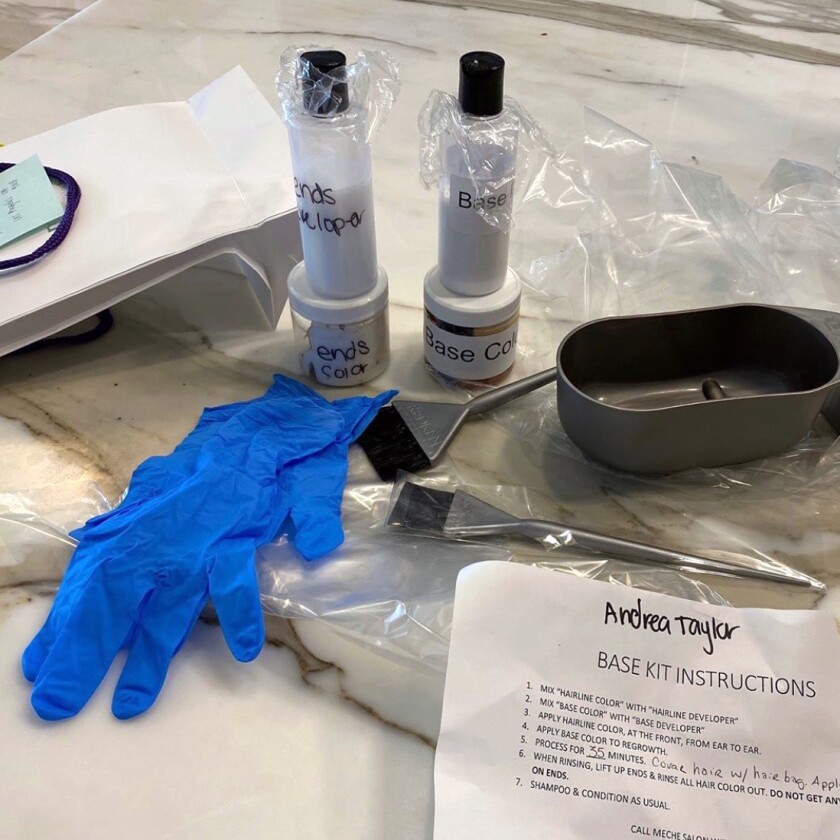 A color touch-up kit sent by Méche salon to Los Angeles client Andrea Taylor. (Tracey Cunningham) Many local pros — from Julia Roberts' hair colorist Kadi Lee of Highbrow Hippie in Venice to Dani Hernandez of Dani H at Sally Hershberger L.A. — are making clients' custom base colors available to them in the form of at-home kits delivered to their doorsteps. Those kits also come along with FaceTime support. (Hernandez, for example, delivered 20 of his $75 kits on Wednesday alone.) The emphasis here is on base color, the experts say. Forget about attempting anything more complex like adding highlights at home. 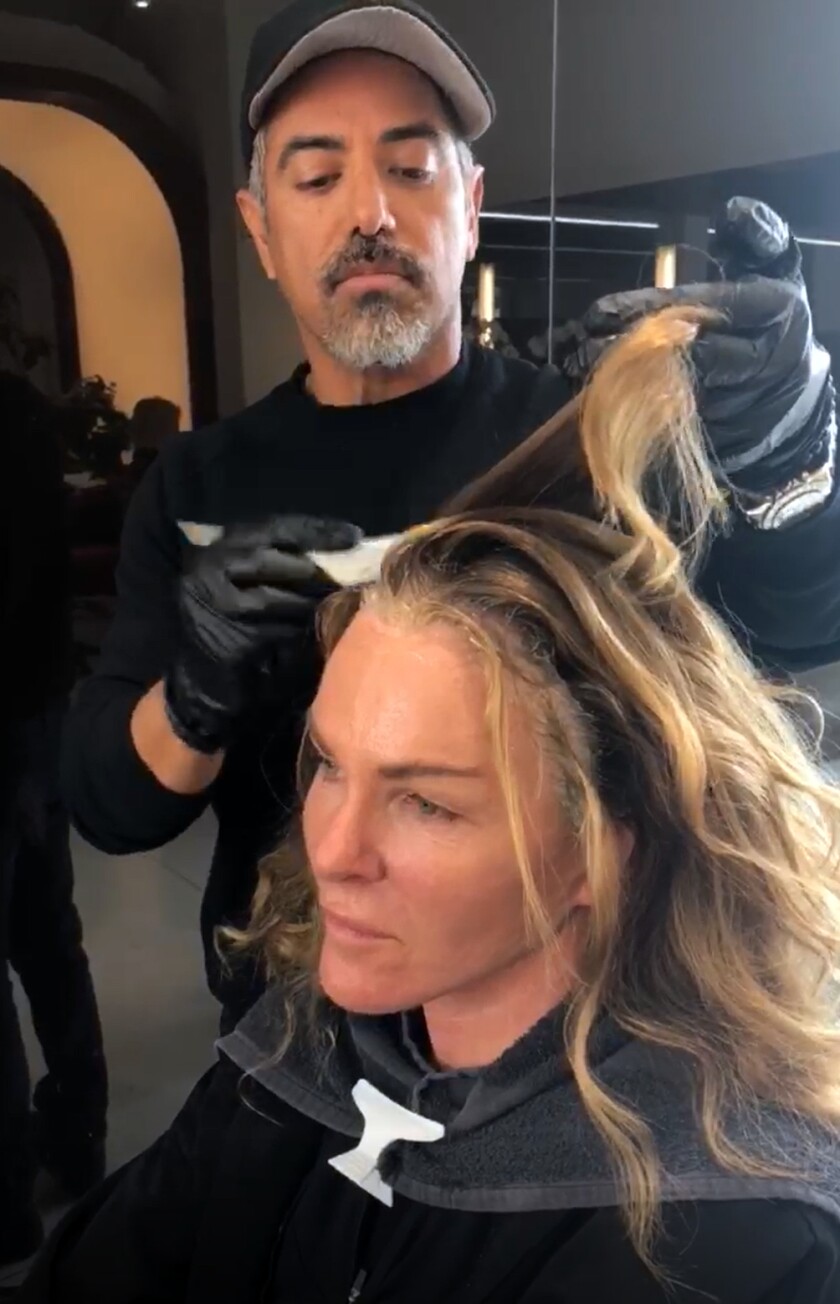 Before the coronavirus lockdown, hair colorist Dani Hernandez works with a client at the Dani H at Sally Hershberger LA salon. (Dani Hernandez) Advertisement For hair colorist Tracey Cunningham, co-owner of Beverly Hills salon Mèche — whose roster includes Jennifer Lopez, Gwyneth Paltrow, Ellen DeGeneres and Portia de Rossi — the kit concept is nothing new. "I've been sending color kits out to my clients to take on trips or tours since the beginning of time," she said.  Hair colorist Tracey Cunningham, co-owner of Mèche salon in Beverly Hills. (Tracey Cunningham) Clients used to bring the base color kit (about $150) to a stylist at their destination, but now with stay-at-home orders in place, they have to apply their color on themselves at home. "We give them a small brush for the hairline and a big brush for the base and put the color in a little Tupperware bowl so it's sealed," Cunningham said. "You mix the peroxide with the color and put it on only at the roots along the hairline and part. Not all over the head." At-home coloring tips Hashtags such as #saveyourroots have been circulating recently on social media in an effort to encourage people to skip buying box kits in support of the hair service industry. However, some people can't resist wanting to color their hair now, especially after glancing in the mirror at gray locks or unflattering dark roots. Hairstylist Kiyah Wright tends to the hair of Laverne Cox, Tyra Banks, Jennifer Hudson and Gabrielle Union at her business Muze Suites within Salon Republic in Beverly Hills. She's on speed dial for color advice. Advertisement 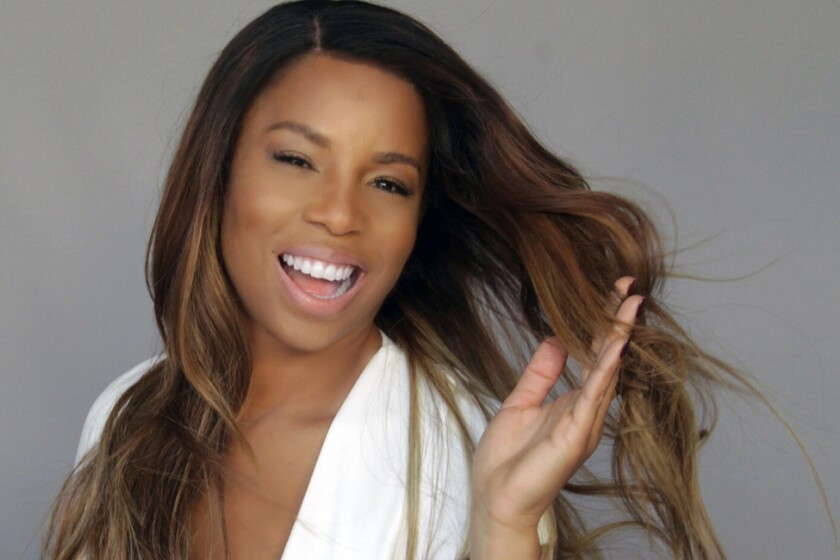 Hairstylist Kiyah Wright operates her hair business, Muze Suites, within Salon Republic in Beverly Hills. (Kiyah Wright) "The women with the gray hairs [growing in] are the ones freaking out, asking me, 'What do I do? There's too much science involved,' " she said. "I tell them to go and get Clairol Beautiful Collection." Clairol's Semi-Permanent Moisturizing Hair Color is about $8 at sallybeautysupply.com and amazon.com and easy to apply. "It works on all hair textures and types, and you don't have to do any mixing," Wright said. "You just squeeze it straight out of the bottle on the roots or all over and rinse it out in about an hour and a half. It is temporary, light and doesn't compromise the integrity of the hair." Cunningham's advice is to be careful when it comes to using box color. "I had a bunch of people call me in a panic, saying, 'Which color do you like the best at Rite Aid?' " she said. "Box colors usually end up darker, and most people's hair is lighter in the front, so we always give everybody a lighter hairline. Buy an extra box in a lighter color for the hairline. Believe it or not, if your hair is a shade too dark, it's depressing." 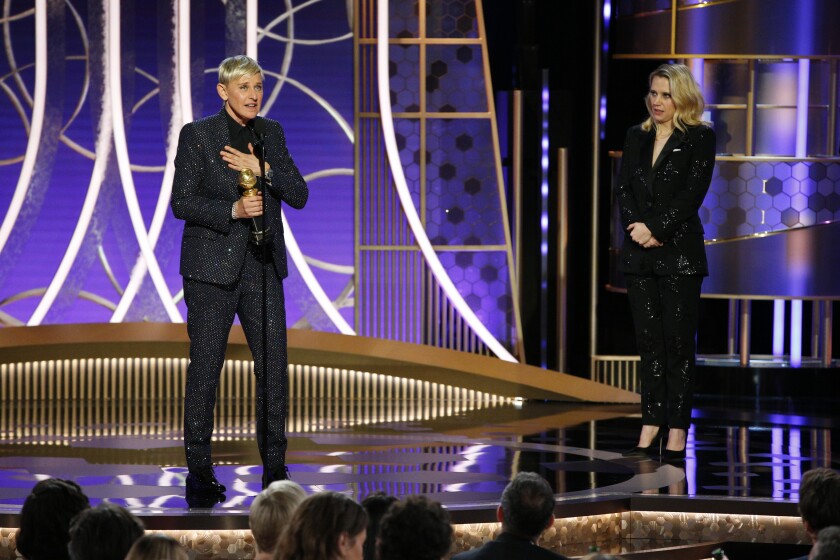 Ellen DeGeneres accepts the Carol Burnett TV Achievement Award at the 77th Golden Globe Awards in January. DeGeneres' hairstylist, Tracey Cunningham, recommends that blonds such as DeGeneres use Malibu C Blondes Wellness Hair Remedy. (Associated Press) For blond clients who don't use base color such as DeGeneres (whom Cunningham texted advice to last week), the color guru recommends Malibu C Malibu Blondes Wellness Hair Remedy and the Hard Water Wellness Remedy for all clients ($3.70 per packet, malibuc.com).  Malibu C Malibu Blondes Wellness Hair Remedy, $3.70 for one packet. (Malibu C) Also, despite what other stylists may say, Cunningham eschews color-correcting shampoos. "Purple or gold shampoos just coat hair with color and tend to make it look even more dull," she said. "And if blondes apply base color to their own hair, they will mess it up so badly. Their hair will go orange." Advertisement Hernandez recommends plant-derived Naturtint Permament Hair Color (about $12, Whole Foods Market and luckyvitamin.com) "for clients who live too far away and need something now to get them through the hump." Also, Moroccanoil Color Depositing Masks ($28, moroccanoil.com) offer a temporary wash of camouflaging color while deep-conditioning hair. "If they feel it's so crazy that they are wanting to use box color, going darker is a lot easier than going lighter," Thompson said. "More people make mistakes trying to lighten a dark base and, when done incorrectly, it can be so difficult to fix."  DpHue offers a number of hair products that might help you now: Root Touch-Up Kit, $30, Color Touch-Up Spray, $28, and $35 Gloss+, $35, available in multiple colors. (DpHue) She recommends home hair-color maintenance brand DpHue as another option after tracking down a hard-to-find copper hue for a client. Mark Ferdman, chief marketing officer of DpHue, told The Times that business is up "over 1,065%" since March 19, with 90% being new customers "driven by the Root Touch-Up Kit product, in seven shades." The kits are available for $30, and the brand is doing a commission split with colorists who place orders through the DpHue Pro app. Root touch-up powders, sprays and pens 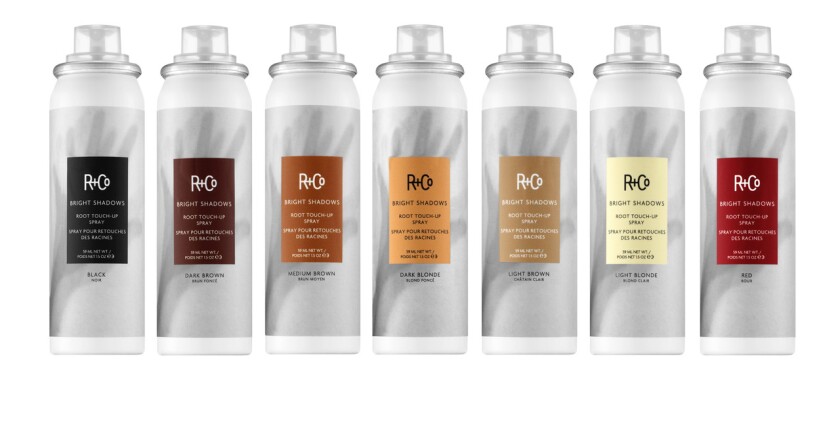 R+Co Bright Shadows Root Touch-Up Spray, $26, in seven colors. (R+Co.) A temporary solution for color outgrowth that all the pros proposed is root touch-up products. R+Co Bright Shadow Root Touch-Up Spray ($26 in seven colors with a light bergamot-fig-floral scent, randco.com) debuted last month. Oribe Airbrush Root Touch-Up Spray ($32 in six shades, oribe.com) offers UV protection.  L'Oréal Paris Magic Root Precision Temporary Gray Concealer Hair Color Pen, $10.99 in three shades. (L'Oréal Paris) L'Oréal Paris Magic Root Precision Temporary Gray Concealer Hair Color Pen ($10.99 in shades of brown and black, lorealparisusa.com and drug stores) allows for targeted brush application.  Oribe Airbrush Root Touch-Up Spray, $32 in six shades. (Oribe) So does Color Wow Root Cover Up powder ($34.50 in eight hues, colorwowhair.com), a water-resistant, mineral cake powder with a double-sided brush. (Representatives from the brand told The Times that sales in recent days are up 640% compared with the same time last year.)  Color Wow Root Cover Up powder, $34.50 each, in eight shades. (Color Wow) Chris Appleton, a brand ambassador and hairstylist to Jennifer Lopez and Kim Kardashian West, said, "I simply load the powder up on the small end of the brush and press into the root line. The powder is so natural looking and blends seamlessly with every hair color. It also lasts until you wash it out. I not only use it to cover grays, but you can use it to touch up your highlights."  Hair colorist Christine Thompson, co-founder of Spoke & Weal salons, including the location in Beverly Grove. (Spoke & Weal) Colorist Christine Thompson, co-founder of Spoke & Weal, is a fan of root touch-up products. "I've been recommending these products for years to clients while traveling, and the color is more important than the brand," she said. "If hair is really dark brown or black, you can even use a bit of mascara. Some sprays can get messy, so I tend to go for powders, mascaras and crayons that don't move around as much." Braids, weave and extension maintenance Thompson said clients were rushing in to Spoke & Weal earlier this month to have hair extensions removed. Now those who couldn't make it are looking for advice on how to remove extensions at home. "Adhesive-based tape-in extensions usually only last about six to eight weeks. If they get too long, you can get dreading," Thompson said. "Any kind of alcohol or oil will break down the adhesive. Normally my hack is to use hand sanitizer because it's gel-based so you can control where it goes. But now, with the shortage, I have clients use coconut oil or even hair spray." Wright tells clients to use Walker Tape C-22 Solvent (about $7, His & Her Hair Goods in Los Angeles or amazon.com) to remove extensions. "You just squirt it on and let it sit for maybe 30 seconds, and the tape-in extensions just start sliding out," she said. "But if you have the bead extensions, you have to get those removed at the salon so you will need to sit it out." Kari Williams, owner of natural hair-focused Mahogany Hair Revolution salon in Beverly Hills — whose clients include singers Brandy and Kelis — recommends her Dr. K Comb Out Creme ($24.99, drkariwilliams.com) to help detangle and remove tape-in extensions with minimal breakage.  LeAna McKnight, owner of Stylist Lee Hair Studio in West Hollywood, giving instructional FaceTime tutorials to clients. (Stylist Lee) LeAna McKnight, owner of Stylist Lee Hair Studio in West Hollywood, told The Times that she suggests using a brow blade (found at most drug stores) to carefully detach woven-in hair extensions by "breaking hair free from the threads at the base to prohibit hair damage caused by trying to cut them out." Maintenance is key after extension removal as well as for women with braided, twisted and knotted styles that last about two months. 
(Dr. Kari Williams) "I am talking to clients about keeping their hair clean and moisturized and protected until they can get back into the salon," said Williams, who also suggests her Dr. K Daily Spray (also $24.99) to keep hair hydrated. "The men I serve have locks, and they normally wait so see me to shampoo, so I'm also speaking to them about washing hair in the shower or with the help of a significant other. During this time, it's most important to focus on hair and scalp health. A lot of damage happens when people try to experiment." Williams' go-to for a deep clean to remove oil and product build-up is Paul Mitchell Tea Tree Special Shampoo ($6.50, paulmitchell.com) followed by a moisturizing shampoo and a deep conditioner (cover hair with a shower cap, plastic bag or Saran wrap) for up to 30 minutes. Before hair is completely dry, Williams suggests sealing in moisture with a hair oil such as those by Eden BodyWorks.  Dr. K Comb Out Creme, $24.99. (Dr. Kari Williams) "The first thing you need to do — I'm talking about ethnic women with or without hair extensions — is to buy yourself a hood dryer," said Wright, who also owns the wig and hair extensions business Muze Hair, which she said hasn't been affected by any delayed shipment of imported hair. "It is great for a mask treatment, to set your rollers or to dry your weaves" which need to go under the dryer for 45 minutes after a shampoo, she said. "If you don't want to do too much, put witch hazel or Sea Breeze in an applicator bottle and squeeze it onto the scalp for a fast cleanse." (Sea Breeze is about $6 and sold at drug stores including Walgreens.)  Muze Hair by Kiya Wright Kinky-Straight Clip-In Hair Extensions, $215. ( Texture and styling tricks Another concern is how to retouch relaxed hair, a chemical salon service that McKnight does not recommend attempting at home. She advises clients use a clarifying shampoo, followed by a moisturizing shampoo. "After that, extend the curly hair at the roots that has not been chemically treated by slightly pulling it as you blow dry," McKnight said. "Then go in with a ceramic flat iron on medium heat." As for styling solutions to mask hair woes, Williams said, "This is the opportunity to two-strand twist or braid your own hair. And wigs are the savior for women who don't want to or don't know how to style their own hair." She also suggests using beach sarongs, neck scarves or cute T-shirts as hair wraps. "Tie a couple knots, tuck and roll," Williams said. "Or clip-in extensions are great to add fullness and volume to the hair and give it some quick style." Cunningham counsels clients to "do two or three little Princess Leia buns or twists on the top of their head" to create natural waves, while deep conditioning and strengthening hair with Olaplex products.  Hairstylist Ashley Streicher, co-owner of Striiike beauty studio in Beverly Hills. (Ashley Streicher) Beverly Hills hairstylist Ashley Streicher, whose clients include Mandy Moore and Sarah Paulson, offers this advice for what not to do. "Pulling your hair back is probably the worst, because it emphasizes any color outgrowth and the line of demarcation," she said. Streicher suggests heat-free styles that emphasize natural texture such as loose French braids to "mask split ends or messed-up haircuts" while simultaneously creating tousled waves. Bang trims Hairstylists might plead with clients to not attempt at-home cuts right now, but Streicher relents at a bang trim. Her step-by-step tutorial on Instagram advises cutting the hair in strategically divided sections, using a "tiny, sharp scissors" (such as those used to trim cuticles or eyebrows). "Angle the sides slightly longer to create more of a curtain bang," she said. Men's hair shape-ups For men looking to trim their shaggy bits of hair, Thompson recommends hair trimmers sold at drug stores. However, handle them with caution. "Hair usually grows out first around the ears, neck and sideburns so they can clean up around the edges on their own if they want to stay groomed, but I highly recommend using the comb attachment," she said. "You can make it longer or shorter. Make it longer first, so there is room for error." Wright agrees. "Black guys tend to shape up their whole hairline with T-blade edgers, and white boys shape up their sideburns and the hair at the neckline," she said. "Give yourself a shape-up, including shaving your face and mustache, and you'll feel like you've had a haircut. Guys aren't so into product, but get some pomade and slick down the sides to give the hair a more tapered look without doing too much." Or perhaps let actor Kevin Hart be your hair role model and go for the gray. The actor recently posted a photo of himself on Instagram that revealed his newly salt-and-pepper hair and beard with the caption: "I have always had a ... load of gray hair … I was just a frequent dyer. I'm not working right now so I said ... IT." "Embrace the gray, embrace the curls, embrace whatever your natural color is," Williams said. "Now is the time to really tap in and love on your hair in its current condition. Get to know it." |
| Shades of 50: how the midlife woman went from invisible to the main event - The Guardian Posted: 21 Mar 2020 12:00 AM PDT At the end of the Versace show in Milan last September, Jennifer Lopez burst on to the catwalk in a blaze of glory. Chin proud, shoulders back, her vibe was somewhere between a bride making her church entrance and a cowboy kicking open the doors of a saloon bar. Split to the waist, the panels of her jungle-green dress floated on her slipstream as she sailed through the firefly cloud of camera phones. Her dress, with its navel-deep plunge, was That Dress – the one she had worn to the Grammys two decades earlier, the one that famously inspired the creation of Google Images. A pop culture goddess was reincarnated, shortly after her 50th birthday, and I whooped and clapped and joined in the confetti shower of fire emoji and heart-eyes raining down around me. I am four years younger than Lopez. I harbour no catwalk ambitions whatsoever – the thought of that is making me chuckle gently to myself in my low-key, middle-aged way as I write – but I felt something joyous in Lopez owning that runway. Along with every other forty- or fiftysomething woman watching, in the room or on Instagram, it felt that I was in some way cheering for my team. Cultural underdogs since for ever, midlife women are suddenly scene-stealers. At Paris fashion week last month, Helena Christensen (51) starred in the Balmain show, while Yolanda Hadid (56) joined her daughters Bella and Gigi on the catwalk at Off-White. When Jennifer Aniston appeared on the cover of Interview magazine for her 51st birthday, it was her bottom-half pairing of over-the-knee Celine leather boots and Alaïa knickers that made headlines, rather than anything she said. Last month, Lopez joined forces with Shakira – a mere baby at 43 – for a Super Bowl performance that ripped up the rulebook about what an on-stage duet looks like at their age. Instead of matronly gowns, sturdy chignons and stately ballad-singing, think peephole leathers and choreography involving poles and hair-whips. 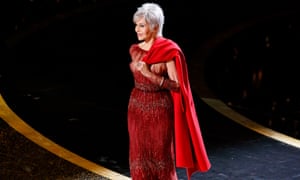 Until now, 50 equalled invisible. The facts of real life – such as the findings of a report by Prof Lynda Gratton for the Longevity Forum two years ago, which found that age discrimination in the workplace began at 40 for women and 45 for men – have long been embedded in our culture. A diversity study for the University of Southern California found that, of films released in 2014, only 21.4% of characters over 40 were female. In 2015, a then 38-year-old Liv Tyler remarked that "when you're in your teens or 20s, there is an abundance of ingenue parts which are exciting to play. But at my age, you're usually the wife or the girlfriend – a sort of second-class citizen." In 2011, the 40-year-old actor Junie Hoang brought a lawsuit against IMDb for revealing her age, alleging that this had cost her work in an industry in which "youth is king". There are structural reasons why the sands are shifting. As life expectancy increases, the meta-timetable that governs our lives requires redrafting. We are getting married later, having children later, so it is logical we tip into middle age later. No point rushing through life's journeys and then twiddling your thumbs at the departure gate, as it were. There are practical reasons, too, why a swelling older population should stay fit and productive. Generations Y and Z have enough on their plates without being expected to foot the bill for half-centuries of feet-up retirement. But this is not just about 50 being the new 40, an extra decade of (relative) youth tacked on to our lives like a side-return extension. When Gloria Steinem fired off her famous riposte, telling an interviewer who complimented her on not looking her age that "this is what 40 looks like", it seemed then that the way she looked was a reflection of her spirit. Steinem was talking about how she carried herself, her body language, the clothes she wore, her choice of hairstyle – not just her skin texture or jean size. Meanwhile the modern rebranding of 50 is really all about the visual element: the smooth skin, taut abs, being able to wear the same revealing dress you wore two decades earlier. Which is why, somewhere between J-Lo's Versace plunge and Aniston's Alaïa knickers, I started to wonder. Was I falling a teeny bit out of love with midlife's new look? There are only so many times you can hear the word "empowering" used about somebody's abs before it starts to niggle. What's more, I can't help noticing that the world has begun championing midlife women at the precise moment when advances in cosmetic surgery, skincare science and "tweakments", alongside a boom in the diet and fitness industries, means that it is possible – with enough money, and knowhow, and leisure time – to spend your way out of the visible ageing process, the same way you could once spend your way to having a Hermès Birkin. Call me an old cynic, but I'm not sure that this is entirely a coincidence. 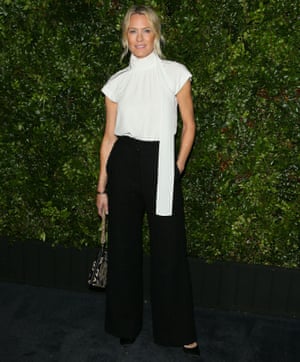 The fashion industry has been central to this rebranding of midlife. Donatella Versace has been the silent partner in Lopez's half-century renaissance: remaking the iconic dress, casting her in September's Versace show, creating a bespoke layered wardrobe for her Super Bowl performance. For the Interview magazine shoot, Aniston wore a bra top – and not just any bra top, but the Givenchy pink satin number worn in the catwalk show by Kaia Gerber, the 18-year-old supermodel daughter of Cindy Crawford. At the Golden Globes in January, Gwyneth Paltrow, 47, wore a Fendi dress the density of a single sheet of tissue paper, the herringbone lines of her external oblique muscles clearly visible on either side of her torso. A new, aspirational version of midlife is a powerful marketing tool to win a lucrative customer base of older women with money to spend on becoming the best versions of themselves – whatever that means. Long gone are the days when a cameo by an ex-supermodel was a novelty at fashion week: these days, the catwalks are packed with more lithe fortysomethings than a £25 north London yoga class. When Meryl Streep was featured on the cover of Vogue, aged 62, in 2011, she was the oldest woman to do so; that record has since been broken several times, most recently by Lauren Hutton, who was nearly 74 when she made the cover of Vogue Italia in 2017. In 2012, a New York Times article about the rise of the older model quoted a casting agent who dismissed it as "just a fad", but this has been proved wrong. The "sophisticated" division of Wilhelmina Models in New York, a spokeswoman recently told the LA Times, is the company's fastest growing area. The omerta around cosmetic surgery, and to a lesser degree Botox and fillers – or "sprinkles" as the latter two are known on the front row – cannot disguise the fact that the faces of many prominent midlifers are strikingly unlined and gravity-defying. The only person worth quoting on the topic, in my view, is 53-year-old actor Robin Wright, who, when asked whether she had tried Botox, told an interviewer, "You bet. Everybody fucking does it! I suppose I can't say 'everybody' because I don't know for sure, but come on!" Interestingly, while any lines deeper than the lightest etching of crow's feet have been all but eliminated from public-facing midlife, silver hair has come into vogue. Finally, the silver fox has gone gender neutral. Sharon Osbourne recently swapped her trademark crimson for an elegant Miranda Priestly platinum. Erin O'Connor walked the Tommy Hilfiger show at London fashion week with her once-raven hair now salt-and-pepper. Kim Kardashian, Ariana Grande, Lady Gaga, Zosia Mamet and Cara Delevingne have all experimented with silver. 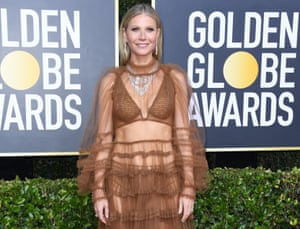 In other words, this is not as simple as letting your roots grow out. Cheering though it is to see silver hair celebrated, note that it is sleek and salon-glossed, not flecked or wiry. (Jack Martin, the colourist who created Osborne's new look, and who was responsible for 82-year-old Jane Fonda debuting her silver hair at this year's Oscars, has become the silver-fox guru, booked solid for months.) As with so many aspects of the new-look midlife, this kind of silver hair requires a considerable outlay of time and money, and a rigorous schedule of upkeep. This is all part of the package: a disciplined routine of 10-step beauty regimes, daily workouts and rolling beauty appointments. It's enough to make you pine for the prospect of being allowed to let yourself go. But optics are always about more than appearance. In my more churlish moods, the rebranding of midlife grates as a cheap trick to convince women to spend even more of our lives obsessing over our thighs. And that ageing is an embarrassing problem, one we can solve by throwing money at it. And still, there is a deep and true joy to be felt in a Lopez or Aniston showing what 50 can look like – because in our visually oriented culture, what 50 looks like is a statement about what 50 can be: relevant, fabulous, top-of-your-game. As the silver-haired, sexagenarian swimsuit model Yazemeenah Rossi told the Observer: "I may be a certain age, but I have a sexy look. Sexy means alive. I'm alive!" The new-look midlife goddess is a powerful totem. I will bow down in worship, even if I don't entirely believe in it. • If you would like your comment on this piece to be considered for Weekend magazine's letters page, please email weekend@theguardian.com, including your name and address (not for publication). |
| Posted: 03 Mar 2020 02:34 AM PST CNN Style has launched a dedicated Beauty section. Read more Beauty stories here. Aspiring actress Nara Kang puts on a coral red lipstick and gently rubs orange blush onto her cheeks, the white glitter swept under her eyes sparkling as she tilts her head in the light. Kang would never have been able to do this back home in Chongjin, North Hamgyong Province. "Putting on red lipstick is unimaginable in North Korea," she says. "The color red represents capitalism and that may be why North Korean society does not let you wear it." Kang now lives in Seoul, South Korea. The 22-year-old fled North Korea in 2015 to escape a regime that restricted her personal freedoms, from what she wore to how she tied her hair. Most people in Kang's hometown were only allowed to wear a light tint on their lips -- sometimes pink but never red -- and long hair had to be tied up neatly or braided, she says.  "Putting on red lipstick was unimaginable in North Korea," says Nara Kang. Credit: CNN Kang would walk through alleys instead of main roads to avoid encountering the "Gyuchaldae," North Korea's so-called fashion police. "Whenever I put on makeup, older people in the village would say that I'm a rascal smeared with capitalism," recalls Kang. "There was a patrol unit every 10-meters to crackdown on pedestrians for their looks." "We weren't allowed to wear accessories like this," she says, pointing at her silver rings and bracelets. "Or dye our hair and let it loose like this," she gestures to her wavy locks.  A staff poses next to a board displaying approved hairstyles at a women's salon in the Munsu Water Park complex in Pyongyang, North Korea in 2018. Credit: Carl Court/Getty Images According to two defectors CNN interviewed for this story, who left the regime between 2010 and 2015, wearing clothes perceived as "too Western" such as miniskirts, shirts with written English and tight jeans, can be subject to small fines, public humiliation or punishment -- though the rules vary in different regions. Depending on the alleged offense or the patrol unit, the defectors said some offenders were made to stand in the middle of a town's square and endure harsh criticism from officers. Others were ordered to perform hard labor. "Many women are instructed or advised by (their) house, school or organization to wear tidy clothes and (have a) clean appearance," explains Nam Sung-wook, a professor of North Korean studies at Korea University.  Pedestrians wait for a bus in Pyongyang, North Korea in 2017. Credit: Ed Jones/AFP/Getty Images They may have been living in one of the world's most restrictive states, but Kang says she and other North Korean millennials still kept up with fashion trends outside the country. It's easy, she says, if you know where to look.
Black market cultureTranslated as "marketplace," Jangmadang is the name given to the local North Korean markets that sell everything from fruit, clothing and household products. They started prospering during the great famine in the 1990s when people realized they couldn't depend on government rations. Many North Koreans still shop at these markets for daily necessities, but they are also the source of illegal products smuggled into the country. Foreign content, including movies, music videos, and soap operas, is copied onto USB drives, CDs or SD Cards in South Korea or China and smuggled into North Korea, according to the South Korean Unification Ministry. This is also a method that many human rights organizations use to send in information challenging the regime.  Activists fill water bottles with rice, cash and K-pop-filled USB sticks to be thrown into the sea towards North Korea on Ganghwa island, South Korea in 2018. Credit: Ed Jones/AFP/Getty Images "North Korean young urbanites are getting culture from the outside world," says Sokeel Park, South Korea country director of research and strategy for human rights group Liberty in North Korea. "This has an effect even in fashion trends, hair styles and beauty standards inside North Korea," adds Park. "If young North Koreans watch South Korean TV programs, they may want to change their hair or clothes to what South Koreans look like."  Joo Yang puts on a pearl necklace she designed in Seoul, South Korea. Credit: CNN Before she fled North Korea in 2010, defector and now jewelry designer Joo Yang says she and her friends used to visit the Jangmadang markets to find USB sticks with films and popular music videos from South Korea. At the market, Yang says female smugglers would talk in a distinct Seoul accent to attract the attention of young women who had already been exposed to South Korean culture. Sometimes merchants would take customers to their homes where there would be rooms full of clothes and cosmetics, according to Yang. South Korean cosmetics were two to three times more expensive than North Korean or Chinese-made products, she says. She had to pay two weeks' worth of rice to purchase a single mascara or lipstick from South Korea.  Cosmetics display inside a store in Seoul, South Korea in 2019. Credit: CNN The marketplace is so popular with millennials that they are referred as the "Jangmadang generation," says Park, who produced a documentary by the same name examining the lives of young North Koreans and their impact on society. The famine disrupted the schooling system, so many of the Jangmadang generation literally grew up shopping in the markets, and have a greater insight into capitalism than previous generations, he adds. Yang says she has seen the style of women in North Korea evolve based on the looks of popular K-dramas. "If young North Koreans watch South Korean TV programs, then they may want to change their hair or clothes to what South Koreans look like. So this has an effect on fashion trends, hairstyles and beauty standards in North Korea," says Park. He adds fashion and beauty trends extend beyond the surface, they signal an implicit change within the society.
North Korea's beauty industryDespite the absence of internationally-recognized North Korean cosmetics brands, North Korea's state media KCNA claims its cosmetics industry is thriving. In November, Pyongyang hosted a national cosmetics show where "more than 137,000 beauty products" were presented, including "new soaps to help remove waste matter from skin and functional cosmetics (to help) blood circulation, beauty goods and anti-aging cosmetics" according to KCNA.  Kim Jong Un inspects the Pyongyang Cosmetics Factory in 2017. Credit: STR/AFP/Getty Images Kim Jong Un is building on the legacy of his grandfather, North Korea's founder Kim Il Sung who created the country's first cosmetics factory in 1949. Kim Il Sung, who had previously used cosmetics to boost the morale of female soldiers in Manchuria during the battle with Japan, realized the power of beauty in changing people's minds early on. Following his footsteps, the younger Kim is investing in state-run brands Unhasu and Bomhyanggi to develop the "world's best cosmetics," state news agency KCNA reported in 2017. The recent push to develop the domestic cosmetic industry comes amid deepening international sanctions, which have made it even more difficult for North Korea to import high-quality ingredients and products, according to Professor Nam. Nam said Kim saw also an opportunity in the growing popularity of South Korean beauty products to produce his own version of Korean cosmetics for export, taking inspiration from the packaging of South Korean products as well as their popular ingredients like ginseng.  North Korean cosmetics displayed in Nam's office show resemblance to South Korean products' packaging. Credit: CNN Earlier this year, KCNA reported that the domestic Sinuiju cosmetics factory had "developed various functional cosmetics like eyelashes growth serums and beauty masks for acne treatment," and was exporting them to other countries like Russia and China.
'Beauty is freedom'Locally-made cosmetics might be readily available in North Korea, but they don't have the same cache or variety as foreign brands. People who wear smuggled foreign cosmetics are not only experimenting with their own looks, but trying to push the boundaries of what's acceptable in North Korea, Park said. "You are wearing clothes that you are not really supposed to, which has been influenced by illegal foreign media," he said. "Then you're signaling to your community and to your friends that you are kind of different and willing to break these rules that are at least low level."  Joo Yang puts on a red lipstick in her apartment in Seoul. Credit: CNN Pyongyang's attempts to control citizens' personal choices can only go so far, wrote North Korean culture expert at Dong-A University, Professor Dong-wan Kang, in a government-commissioned paper on the topic of South Korea's influence on the hermit kingdom. "Although North Korean authorities crack down on fashion and hairstyles of the so-called decadent culture of capitalism, there is a limit to the total control of their citizens' desire and needs," writes Kang. "Following South Korean influences on clothing, makeup and hair disrupts everyday expectations and can lead to dissatisfaction and skepticism about the North Korean regime. Mimicking South Korea, they are deviating from the society and it shows that a subculture has been formed as a factor of regime resistance." Both Yang and Nara Kang say in South Korea they are able to express themselves in a way they weren't allowed to before. "When I first went to a cosmetics store in South Korea, I swear I thought I went to a toy store in North Korea because there was a huge variety of colors like toys," recalls Kang.  Colorful lip glosses are displayed inside a cosmetic store in Seoul, South Korea. Credit: CNN "For me, beauty is freedom," she says. "Now I have more ownership over my beauty." Yang said a lot of her friends in North Korea were enraged by not being able to dress the way they wanted. "We are brainwashed by the North Korean government, so we still like the Supreme Leader, but the desire to look pretty is another issue," says Yang. "The anger starts building up inside you, questioning why shouldn't I do it?" Park, who works with a lot of newly arrived defectors in South Korea, foresees a bigger change that beauty can bring in North Korean society. The activist explains that the government has become aware of the younger generation rebelling against state-approved culture. This is pushing them to adapt and to allow some degree of flexibility in order to maintain power. "It basically forces the government to answer the question: Are they going to go with this change or are they just going to try and repress (it)?" |
| The Coolest 80s Hairstyles for Men to Rock This Year - The Trend Spotter Posted: 25 Mar 2020 02:40 AM PDT
The '80s were an iconic decade for fashion and style. Today, elements of the era are back – including many hairstyles for men. From the majestic mullet to wild curls and bleached blond punk looks, the '80s offers a wide variety of inspiration for your hair. Check out these modern takes on the retro classics. RELATED: 80s Fashion for Men (How to Get the 1980's Style) 1. MulletThe mullet is one of the most iconic men's hairstyles of the '80s. Short at the front and long in the back, it is surprisingly flattering and suits many different face shapes. Plus, a mullet always stands out from the crowd. From athletes to fashion tastemakers, the mullet is coming back into style. It suits guys who want a statement haircut with a quirky edge.
2. Flat TopThe flat top – a type of high top fade with a smooth, table-like look – remains one of the boldest haircuts for men. Because it looks so unusual, it will ensure all eyes are on you. It suits both Afro-textured and straight hair types. There are several options when it comes to embracing the flat top. You can recreate the classic '80s look by blowdrying your hair straight up and using a strong-hold product to keep it in place. Alternatively, go for a short, neat, modern take that requires less styling and effort.
3. Tall MohawkThe '80s punk era was all about oversized mohawks. A rebellious, wild, and edgy style, the mohawk makes a bold statement and places you at the center of attention. Adapt your mohawk by teaming it with a taper, braided sides, or a fade. You can also give a tall mohawk a more polished feel by slicking it back or give it a rugged, masculine twist by pairing it with a full beard.
4. PermOne of the most iconic trends of the '80s was the perm. However, while the tightly-coiled 'poodle' look may have been fashionable then, today's perms are far more natural and flattering. Perms can last up to six months and can be combined with lots of other styles, like undercuts and fades, for a modern twist. Try a medium length style and use a curl-defining serum or spray to get your hair looking on point.
5. High Top FadeThe high top fade found popularity during the golden age of hip-hop. Back then, the flat top – a very smooth and angular type of high-top fade – was one of the trendiest looks for men. Today, it's advisable to choose a high top fade that suits you. Whether you pair it with twists, a line-up, or another variation, your high top fade will look cool and interesting.
6. Jheri CurlThe Jheri curl is an iconic 1980s hairstyle for black men. Stars from R&B singer Lionel Richie to pop superstar Michael Jackson and rapper Ice Cube had Jheri curls. A specific type of perm, the Jheri curl technique, gives Afro-textured hair loose yet defined curls with a glossy finish. It's a statement style that has a retro appeal and works on all hair lengths, from short to very long.
7. Long WavesLong, curly – or wavy – hair was in style in the '80s. From shoulder-length locks to a wild mane, long hair with natural texture is a sexy and masculine look. Once your hair is long enough, use sea salt spray to give yourself surfer-style waves. Effortlessly cool and relaxed, the style looks as good today as it did back then.
8. Slick BackIf you need inspiration for your slick back, look no further than the 1987 movie Wall Street. Back then, the hairstyle was a favorite among stockbrokers and businessmen. Today, it's popular with guys everywhere. To maintain the wet look of the slick back, use gel and a glossing spray instead of more matte products when you style your hair and use a fine comb.
9. PompadourThe pompadour is all about volume, so it's no wonder it was so popular in the '80s. Like the elephant trunk, the classic pomp came back into style with the '50s revival and rockabilly trends. Opt for the traditional ultra-high, slick pompadour if you want your hair to do all the talking.
10. Shoulder LengthWhile the '70s is best known for long hair, shoulder-length hair became a defining trend of the '80s. Whether curly, wavy, or straight, shoulder-length hair looks great. It has a casual and laidback vibe, and you can wear it loose or tie it back in a low man bun.
11. Bleached HairPop stars like Billy Idol made bleached hair popular three decades ago, and, for guys who aren't afraid to stand out, the trend has never really gone away. If you're thinking of taking the plunge, go to a professional rather than trying it at home. Bleaching can do a lot of damage to your hair, and if yours is naturally very dark, you may require a few sessions to get it to an icy platinum hue.
12. Slick Back QuiffThe quiff is one of the most simple and versatile hairstyles for men. To give yours that 1980s Johnny Depp look, try the slick back quiff. Use pomade to give your hair a semi-wet, almost oily look, and use your hands to push your hair back. The key is to make it look effortlessly cool, rather than smooth and neat.
13. Wild Natural CurlsCurly hair was a massive trend in the '80s. Now it's back in style for men. Whether short, mid-length, or long, guys lucky enough to have waves and coils should make the most of their natural texture. If your hair is naturally straight, try a modern perm. The new techniques and formulas will give you a natural effect, rather than tight coils or the 'poodle' look – some trends should stay in the '80s.
14. Feathered HairThe feathered hairstyle was popular in the late '70s and early '80s, and it is coming back into style now. Developed for straight or wavy mid-length hair, it involves cutting in layers, center-parting, and then pushing the layers back. It looks best on those with angular and longer faces as – like most center-part hairstyles – it can make round faces look even wider.
15. UndercutThe punk movement made rebellious hairstyles like mohawks and undercuts popular in the '80s, and they are still a favorite hairstyle for men today. Pair your undercut with volume and texture for a faux mohawk effect. It will give you all the attitude of the era without making you look outdated.
16. Elephant TrunkAlso known as a messy pompadour or wavy pompadour, the elephant trunk first became popular among Greasers in the 1950s. The Rockabilly trend in the '80s brought it back into fashion, and it was memorably worn by Duckie in the classic movie Pretty In Pink. Today, the elephant trunk makes for an interesting twist on a classic pompadour, and it is still a strong statement.
17. Long Comb Over with TextureOne of the more casual and timeless '80s hairstyles is the long comb over with texture. Part your hair on the side and blowdry it upwards, so there's plenty of lift. Your hair should look volumized, rather than flat, for the classic '80s finish. Next, use a texturizing powder or spray and work it through to add some definition to your hair, so it looks relaxed and casual, rather than fluffy.
18. Pink HairThe '80s New Wave movement was all about self-expression and wild, unnatural hair color – like pink – was part of the subculture's style. Today, guys are embracing pink hair as a cool and stylish statement. Ideal if you work in a creative industry, it shows off your personality and bold attitude. It's still a men's hair color that has a rebellious, subversive, and edgy feel.
SUBSCRIBE TO OUR NEWSLETTERSubscribe to our mailing list and get interesting stuff and updates to your email inbox. |
| You are subscribed to email updates from "top haircuts for women,trendy styles for women,types of haircuts for women" - Google News. To stop receiving these emails, you may unsubscribe now. | Email delivery powered by Google |
| Google, 1600 Amphitheatre Parkway, Mountain View, CA 94043, United States | |


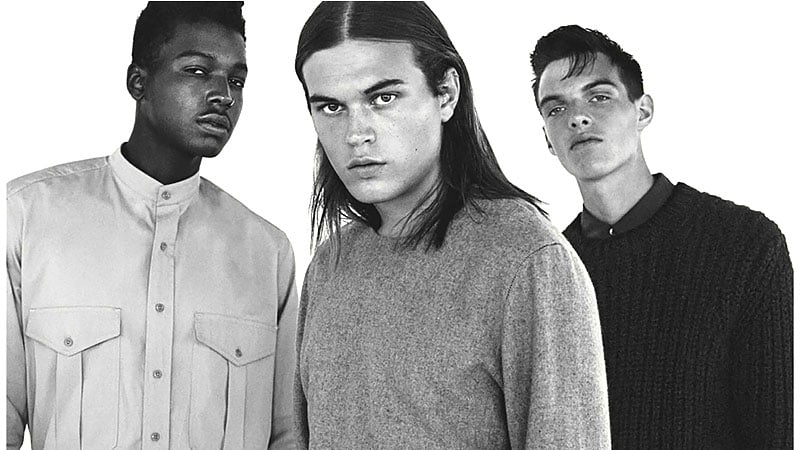
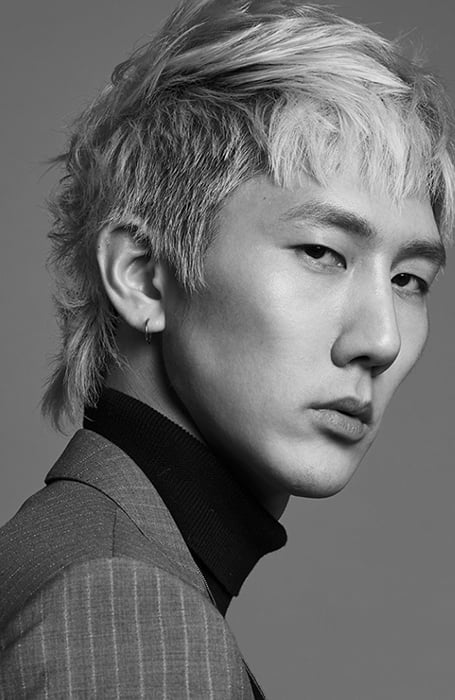
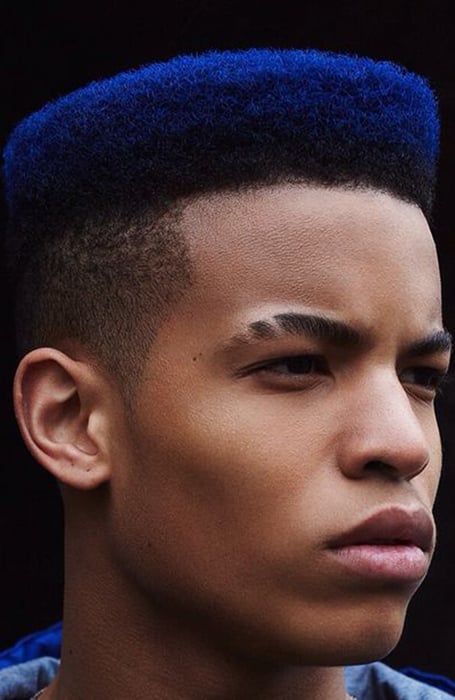
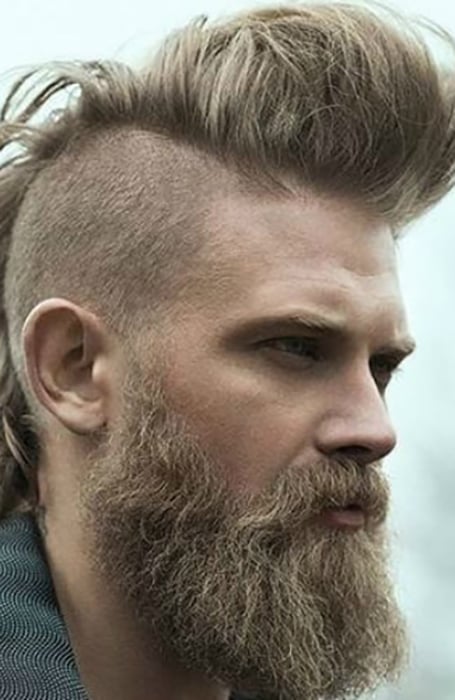
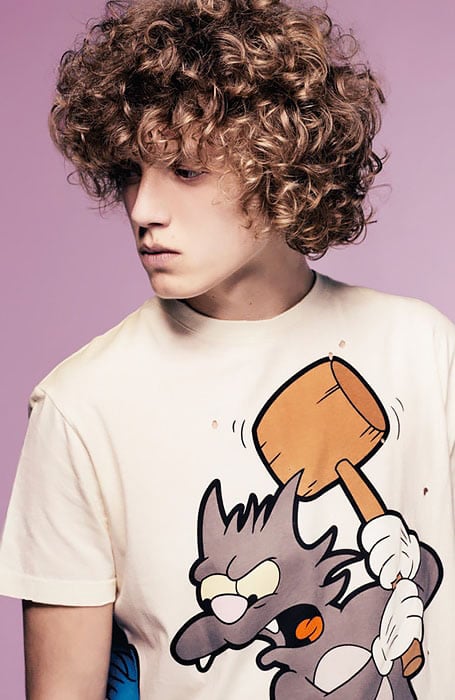
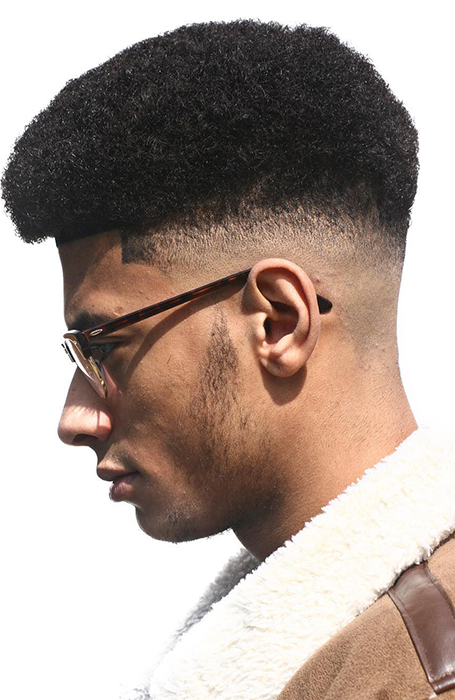
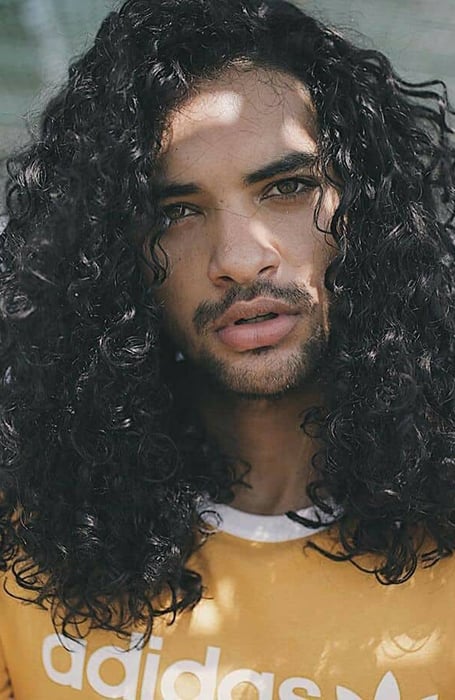
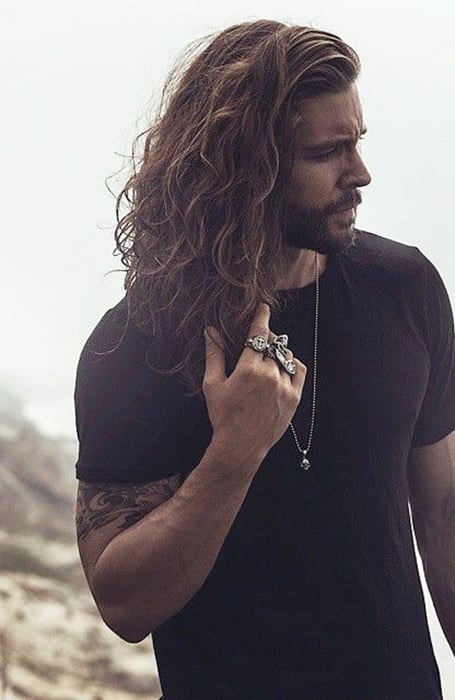
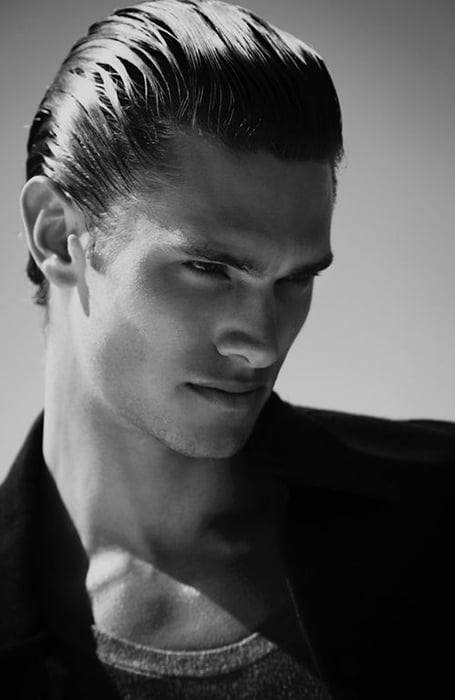
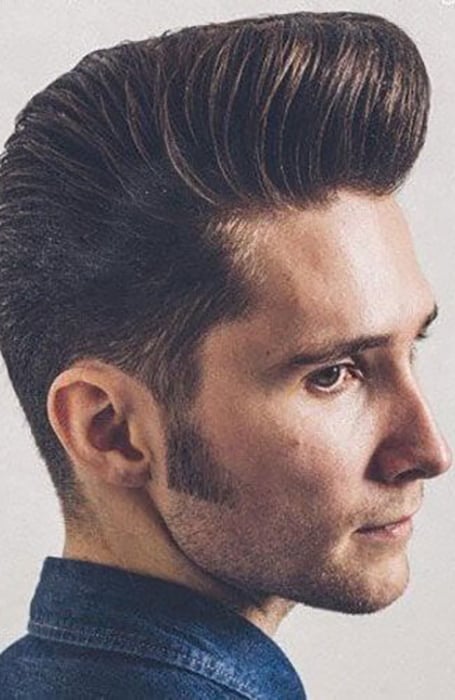
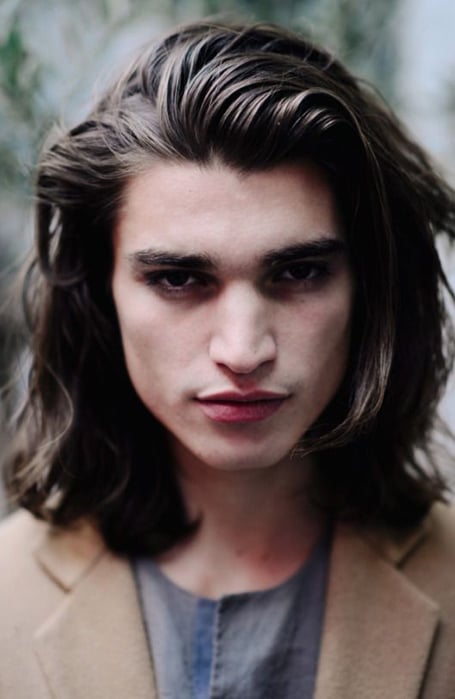
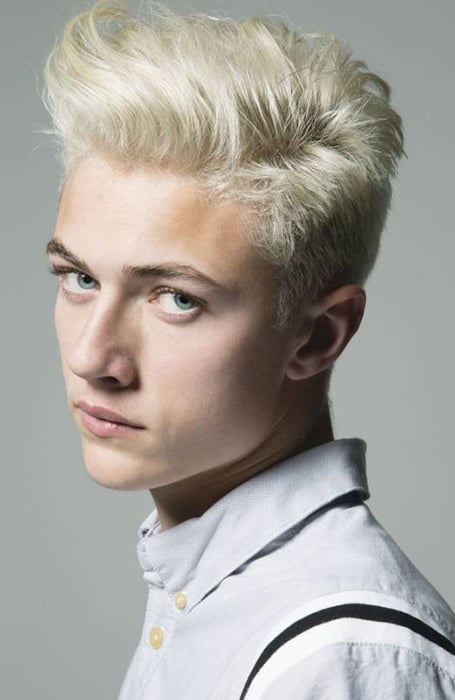
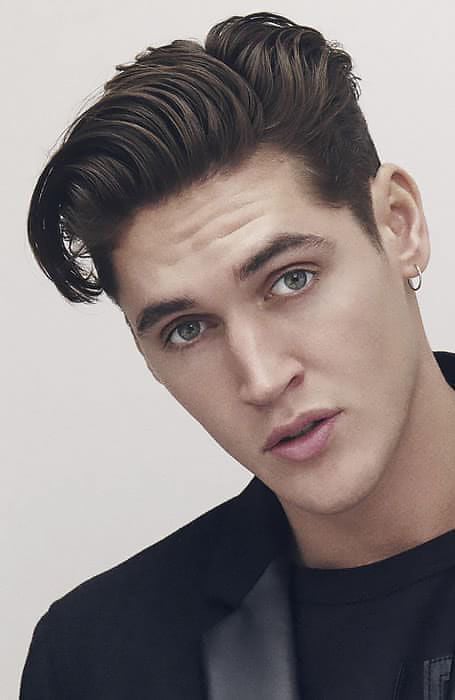
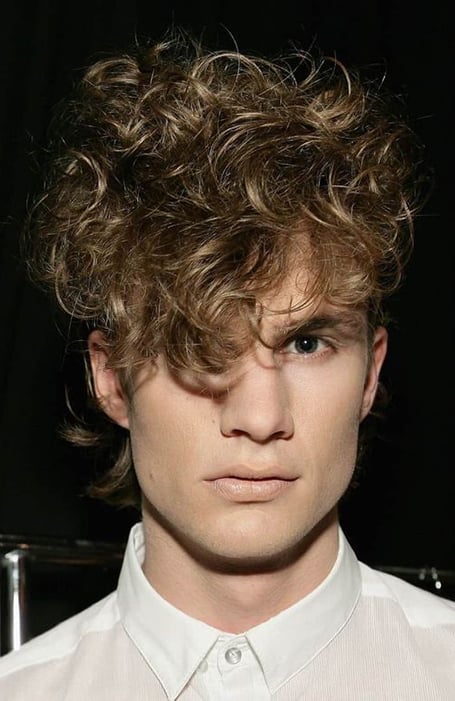
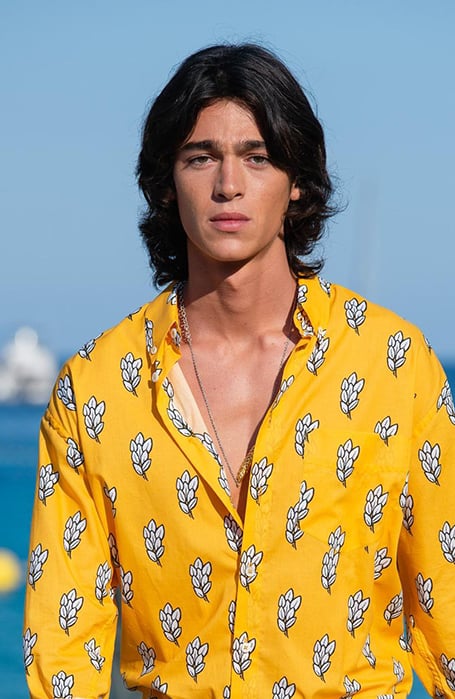

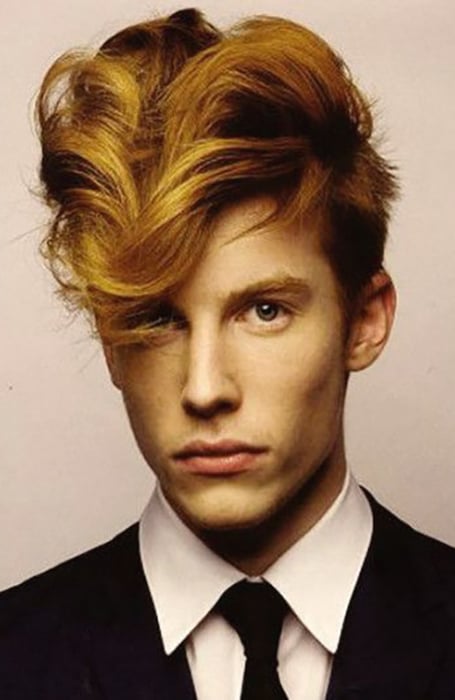
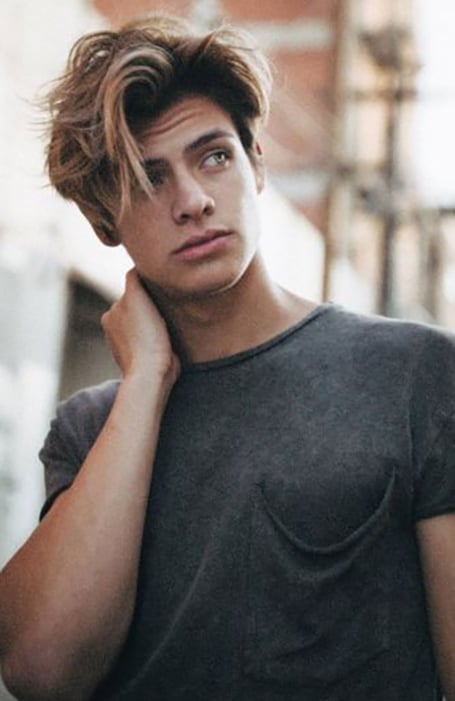
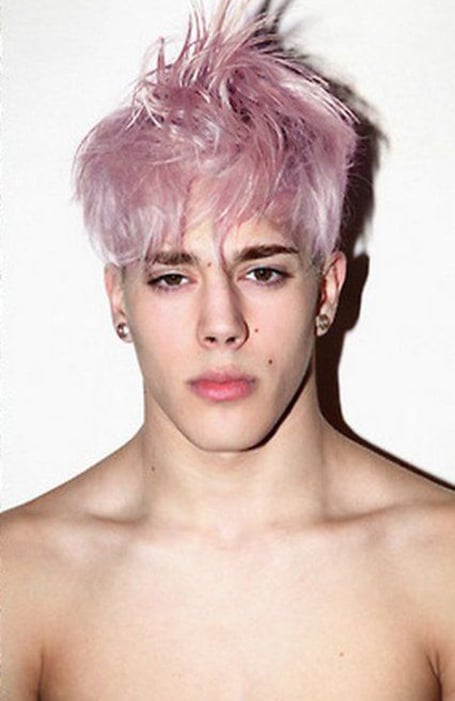


0 Comments